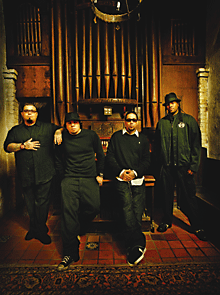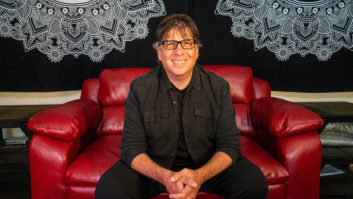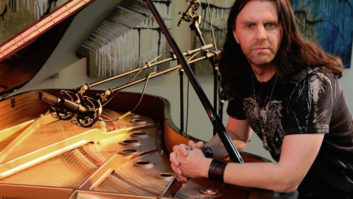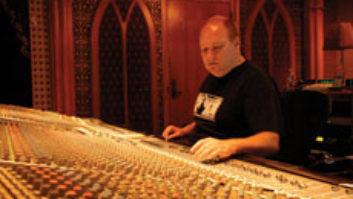

While the masses were wandering around the floor of the 2007 NAMM show, looking for free T-shirts and drumsticks, producer/engineer Jay Baumgardner was meeting with the members of P.O.D. to talk about recording a collection of new material that would feature the return of original guitarist Marcos Curiel after more than four years away from the group.
P.O.D. (which stands for Payable on Death; it has some Christian subtext) burst out of their native San Diego, Calif., hometown onto the national scene when their combination of rap, metal and reggae-dub hit a vein with the 1999 release of The Fundamental Elements of Southtown. Fueled by the singles “Southtown” and “Rock the Party (Off the Hook),” the band’s major-label debut went Platinum. Their second major-label offering, which was released on September 11, 2001, pushed the band over the top with songs like “Alive,” “Youth of the Nation” and “Boom.” Over the years, the quartet has polished its sound and found a combination of rock ‘n’ roll energy and hook-laden choruses that serves as an immediate sonic identifier.
For their latest album, When Angels & Serpents Dance (in stores April 8), Baumgardner and the band — singer Sonny Sandoval, drummer Wuv Bernardo, bassist Traa Daniels and Curiel — found common ground and mutual respect before deciding to head into NRG Studios in North Hollywood. According to Sandoval, Baumgardner was picked to produce and mix the record for a couple of very simple reasons: “He’s got his own ideas and he doesn’t just put [the music] through a system of hit records,” the singer says. “He was a fan of the band and that’s always a plus for us. He’s not just working to make some cash; he’s working because he digs the band.”
P.O.D. are (L-R) Marcos Curiel, Sonny Sandoval, Wuv Bernardo and Traa Daniels.
The sessions started in April of 2007, and the final mix and mastering were completed in January 2008. According to Baumgardner, the original plan was to come out with an album much sooner to kick-start the band’s new deal with Columbia Records. (They left Atlantic in 2006 after eight years and more than 7 million albums sold.) “When we started the record, it was going to be really accelerated, like [the label] needed it done in two months,” he says. “But then they pushed back the release date, as they always do.”
The extra time worked out for the best. It turns out that Curiel had more than an album’s worth of material, but Sandoval hadn’t come up with any lyrics. That’s nothing new for the singer, though. “We’re the kind of band that writes the music and then I let the music lead where the lyrics are going to go,” Sandoval says. “Then I go into the studio and just kind of put it down. I think I frustrated Jay a little bit because he was the first producer who ever wanted all of it at once.”
When they were still working on the two-month timeframe and there were no lyrics in sight, Baumgardner brought in vocal coach and singer Mark Renk to help Sandoval. “We had all this great music and that puts you in a weird, very hard situation when you have to write great lyrics and great melodies for 15 songs in two months,” the producer reports. “I brought Mark in because of this accelerated schedule so I could continue working on the music and he could work on some vocal things. It was one of those things that worked out great because he did an amazing job.”
So while Sandoval and Renk headed off to the latter’s studio, the rest of the band convened in Studio A at NRG. Engineer Sergio Chavez (Alien Ant Farm, Motörhead, The Bees) was responsible for the tracking dates. “It was really simple,” Chavez remarks. “Those guys are pros and they can really play, so there was no crazy trickery or anything like that. Once the foundation was there with the drums, then we were pretty much cool to go.”
According to Baumgardner, the key to the sessions was making sure there were great-sounding instruments in a great-sounding room. “I think that’s more important than doing a lot of fancy processing when you record, so there was not a whole lot of fancy processing,” he says with a laugh. “Most of the record was recorded in Studio A, which has a Neve 8068, so all the drums were recorded through those Neve modules and straight to Pro Tools. I have a great mic selection, and we had great drums. That, in my opinion, is more important than any kind of junk that you would do.”
Keeping that in mind, Bernardo’s drum tracks were recorded with a conventional mic setup — an AKG D 112 and Yamaha Subkick on the kick, Shure 57s on the snare’s top and bottom, Sennheiser 421s on the toms, AKG 451 for the hat and ride, and a pair of Schoeps 222s for overheads. One interesting twist was that Baumgardner used a pair of Royer SF-24 stereo active ribbon microphones as midfield room mics. He also set up a pair of mics to capture far room tones and added a mono mic to the room, just in case there was ever a call for a surround mix. “The more drum mics you have when you do a surround mix the better off you are,” he says. “I didn’t use them for the stereo mix, but they are there in the session.”
Chavez was responsible for both the recording and the comping of the tracks. “If there was anything rushed, I would fix that a little bit, but I didn’t use Beat Detective,” he says. “Jay didn’t want it to be stale like that. That band is a ‘feel’ band — they have a good groove and they do what they do.”
Three weeks later, the crew moved into NRG’s Studio B to record Daniels’ bass tracks. A Sennheiser 441 was put on his cabinet and a DI was taken through an Evil Twin. Both signals went through a Distressor. Where many producers and mixers would look to blend the two tracks, Baumgardner has a one-or-the-other philosophy. “I’m going to let the cat out of the bag and everybody is going to hate me, but at the end of the day I ended up using the DI with the Ampeg SVX plug-in for the whole album,” he says. “It gave me so much more control when I was mixing. I really tailored the bass sound to each song because the album bounces around to so many different things. Even though the sound of the amp was cool, it was better for some songs and some songs it was worse for, and I’m able to dial it right in with that thing.”
As for Curiel’s guitar tracks, both Chavez and Baumgardner continued to keep a simple approach while working in Studio A. Curiel played an assortment of guitars — including a series of Paul Reed Smith custom models — through modified Marshall JCM 800s. He also played through Vox AC30, Mesa Boogie Lone Star and Hiwatt amps. The chain was streamlined, with a 57 on the cabinet through a Neve 1081 into Pro Tools. The overdubs were recorded in Studio B, and the only change was swapping out the 1081 for a 1073.
For the most part, Sandoval’s vocals were recorded at Renk’s studio, which is about two blocks from NRG, and that meant gear could be sent down the road for use during those sessions. Baumgardner used a Neumann U47 through a 1073 and an 1176. That doesn’t mean there wasn’t some experimentation at first. “I’m a constant tweaker,” Baumgardner explains. “We tried several different mics on him and that one just seemed to be the one for his voice.”
The album features guest appearances by Mike Muir from Suicidal Tendencies, Helmet’s Page Hamilton and the Marley Sisters on background vocals. Jason Freese, who serves as Green Day’s touring key-boardist, joined in for one song and Suzie Katayama provided string arrangements.
Baumgardner says he always aims to record entire sessions — music and vocals — as flat as possible. “I try to keep it simple on the recording side because it gives you the ability to go different places or do things on a moment’s notice [in the mix], and it’s easy to match up,” he explains. “I keep it a lot simpler now because I know I’m going to be mixing it. I don’t have to present this finished product to another mixer where they open the faders.”
Everything went through an Apogee Big Ben master word clock into a 96k, 24-bit Pro Tools rig. “No analog tape was harmed during these sessions,” Baumgardner jokes. Yet he took care to make sure the tracks didn’t sound like they were recorded digitally. “Every kid now has a home studio, so what I’m trying to do is go the opposite way and make it sound like it wasn’t being spit out of a computer. I think that’s sort of the trick, to go the opposite of making it sound computerized and quantized and edited to perfection. So use digital tools, but use them in a different way — to enhance the natural sound of things and not overdo it. Any kid can grid a bunch of drums and cut and paste themselves a song.”
While gear certainly helped with that kind of digi-organic vibe, Baumgardner had a definite approach in mind before the recording dates started. Angels & Serpents was all about letting P.O.D. rekindle their relationships and letting that fire the band. “And letting the music speak for itself,” Baumgardner adds. “We were never going to try to make P.O.D. something they are not. My thing was that Marcos was back and we were going to try to use that strength to our advantage. We wanted to make a classic rock record. It’s not a hip-hop rock record. It’s not a nü-metal record. It’s got some tastes of different things, but it’s definitely P.O.D.”

LISTEN: Must Play
“When Angels & Serpents Dance”




